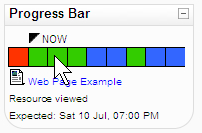|
Name |
Progress Bar |
|
Module Type |
Block |
|
Author |
Michael de Raadt |
|
Released |
2009 |
|
Maintained |
Actively |
|
Languages |
Dutch, English, German, Japanese, Portuguese Brazilian |
|
Compliance |
Good |
|
Documentation |
Online documentation, help files |
|
Errors |
None displayed |
In a course with a large number of tasks to undertake, students can lose track of what activities and resources need to be attempted or viewed next. The Progress Bar block aims to show students what they have attempted and what they still have to complete. Progress is indicated by segments in a bar, with each segment representing a single activity or resource, and each color-coded to show if it has been attempted. The segments are ordered chronologically to show the order that activities/resources should be attempted, and an indication of the current point in time is given.
Unzip and copy the block directory into the /moodle/blocks/ directory then visit the Notifications page.
Once installed you can add a Progress Bar block from the Blocks menu. Initially the block appears with a message prompting the teacher to indicate which activities and/or resources should be shown in the Progress Bar.

It is assumed that you already have created activities and resources in your course. When you click on the configuration icon you are taken to a page that lists each of the activities and resources in your course.

At the top of the configuration page, there are three settings. The first setting allows a teacher to change the block title from the default Progress Bar to some other name. If the block is used to indicate progress in a particular type of activity, say assignments, then the block could be used to show progress for just that. If that were the case, using a title like "Assignments Submitted" may provide more information. It is possible to have more than one Progress Bar block on a page with each used to show progress in different activities, and each titled appropriately.
The second setting adds tick or cross icons to Progress Bar segments. Adding these symbols provides another level of meaning to the color-coded bar segments. This may be useful if students in a class are known to be color-blind, or if the red and green colors used are not indicative of good or bad in the cultural setting of the course.
Note
Segment colors in the Progress Bar can be altered to match cultural meanings, or to match themes. This is accomplished using the global configuration settings for the block at Site Administration | Modules | Blocks | Progress Bar.
By default, the block adds an indication of the current point in time above the bar. If ordering is not relevant in a course, or if the course is not conducted over a specific time-frame, this indicator can be turned off.
The remaining settings relate to activities and resources in the course. The block is designed to work with all standard activities and resources. The commonly used Feedback and Book modules are also included. Activities and resources are grouped together in kind; for example, all assignments are grouped together. For each activity there is an expected level of involvement labeled Action, which is indicated on the right hand side of each group heading. This action indicates what students are expected to do in order to notionally make an attempt. With assignments students need to submit in order to turn the relative Progress Bar segment green.
Next to each activity there is a checkbox that, when enabled, includes the activity in the displayed Progress Bar. If an activity is checked, but hidden in the course, it will not appear in the Progress Bar. This is useful if a scheduled release of work is achieved by revealing hidden activities and resources as the course progresses; as activities selected in the configuration are unhidden, they will automatically appear in the Progress Bar.
Some activities, such as assignments and quizzes, can have a due date associated with them. If a due date is set, that date is used as information for the ordering of segments in the Progress Bar. These due dates can be overridden if the teacher wishes to do so. For activities and resources that do not have a due date set, the teacher must supply a date and time that it is expected to be attempted by.
With activities and resources selected, the Progress Bar appears to students indicating their progress in the course.

The display will differ for each student, depending on what they have accomplished this far. Segments colored red indicate a task that has past and is yet to be attempted; green indicates that an attempt has been made and blue shows tasks that have not been attempted, but are expected in the future.
When a student moves their mouse over a segment of the Progress Bar, the block expands and reveals information about the related task.

Students can click on a block segment or the name of the activity to be taken to it.
